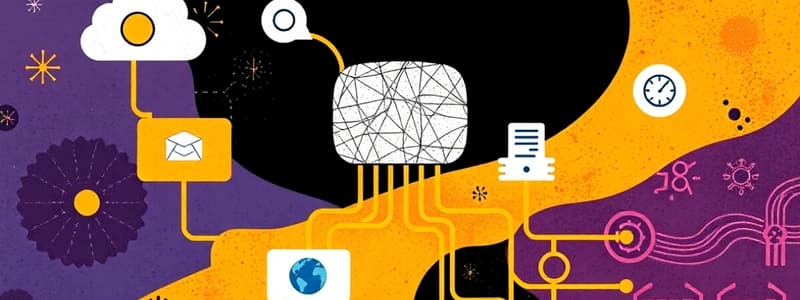Podcast
Questions and Answers
What does SOA stand for?
What does SOA stand for?
What is the primary goal of SOA?
What is the primary goal of SOA?
Achieve loose coupling among interacting and contracted services.
Web services are tightly coupled components.
Web services are tightly coupled components.
False (B)
Which of the following is a main benefit of SOA?
Which of the following is a main benefit of SOA?
Signup and view all the answers
The communication in SOA is based on ____ agreements.
The communication in SOA is based on ____ agreements.
Signup and view all the answers
Which protocol is used for transferring information between peers in web services?
Which protocol is used for transferring information between peers in web services?
Signup and view all the answers
What does WSDL stand for?
What does WSDL stand for?
Signup and view all the answers
The Universal Description Discovery and Integration (UDDI) serves as a repository for WSDL documents.
The Universal Description Discovery and Integration (UDDI) serves as a repository for WSDL documents.
Signup and view all the answers
Match the following web service technologies with their descriptions:
Match the following web service technologies with their descriptions:
Signup and view all the answers
What is a strong motivation for businesses to adopt SOA?
What is a strong motivation for businesses to adopt SOA?
Signup and view all the answers
Study Notes
Introduction to Web Services and SOA
- SOA is a collection of services that can communicate with each other
- Services are what is connected together, typically web services
- Communication is facilitated through interface agreements and internet protocols
- SOA is built on concepts similar to RPC (Remote Procedure Call), like RMI (Remote Method Invocation), CORBA (Common Object Request Broker Architecture), and DCOM (Distributed-Component Object Model)
Formal Definition of SOA
- SOA is an architectural style focused on achieving "loose coupling" between interacting services via communication protocols
- It is an internet-native distributed computing model
- "Service-oriented" supports dynamic service description, publication, discovery, and usage
The Trinity of SOA
- SOA has three key parts: Services, Consumers, and Providers
Web Services
- Web services are loosely coupled, contracted components that communicate through XML-based interfaces
- Loosely coupled means web services and their invoking programs can be independently changed
- Contracted means that a web service's behavior, its input/output parameters, and bindings are publically available
- Components are encapsulated code with hidden internal implementations
- XML is a human-readable, text-based format, firewall friendly and self-describing
Key Web Services Technologies
- SOAP (Simple Object Access Protocol) is a messaging framework for transferring information between peers over the web
- It uses XML for decentralized and distirbuted communication
- WSDL (Web Service Description Language) is an XML-based way to describe and express the interface of a web service
- UDDI (Universal Description Discovery and Integration) is a repository for WSDL documents.
Web Services and SOA
- There is often confusion between web services and SOA
- They are different, but closely related concepts
The Business Case for SOA
- Business motivation for SOA includes:
- Broad intra and inter operability
- Future e-business interoperability via the internet
- These requirements lead to high IT complexity and costs, and demand for quicker response
- Benefits of SOA:
- Reduced costs by leveraging existing legacy services
- Incremental revenue by assembling existing services
- Integrated value chains for e-business collaborations
- Highly dynamic and distributed applications
- Achieve “just in time” integration
Technical Motivation for SOA
- Goals of SOA include:
- Software reuse and integration
- Challenges from the previous generation of RPC models, such as RMI, CORBA, and DCOM, include:
- Single-vendors, non-interoperable solutions
- Binary, non-readable protocols
- Tightly coupled systems only
- SOA aims to solve these problems
Interoperability
- The Web Services Interoperability (WSI) Organization aims to:
- Ensure web services interoperate across platforms, applications, and programing languages
- Accelerate web services deployment by setting standards
- Provide guidance, tools, samples, and best practices
- Facilitate discussion and meetings
E-Business
- E-business is the marriage of traditional supply chain management with the internet
- Includes:
- E-commerce (B2C, C2C): direct transactions and point-of-sale
- E-procurement (B2B): processes by which a manufacturer obtains products from suppliers
- E-collaboration (B2B): information sharing and collaborative planning
Studying That Suits You
Use AI to generate personalized quizzes and flashcards to suit your learning preferences.
Related Documents
Description
Explore the fundamentals of Service-Oriented Architecture (SOA) and web services in this quiz. Learn about the key components, communication protocols, and the significance of loosely coupled services. Test your understanding of the concepts that underpin modern distributed computing.




